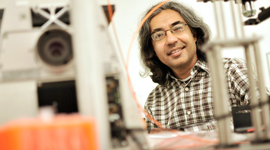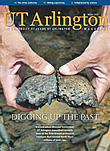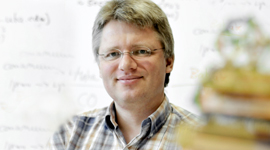Operating instructions
Advanced surgical platform gives doctors a clearer view inside the body
Most people associate joysticks with airplanes or video games. But UT Arlington researchers are using the lever-like devices to help surgeons know where to operate.

Dr. Digant Davé is building a surgical system to help doctors see through scar tissue when operating.
Bioengineering Assistant Professor Digant Davé and his team have received federal funding for the multifunctional, image-guided surgical platform. MIGS integrates a high-resolution, depth-resolved optical imaging system, a laser scalpel, a motorized positioning system, software and a control system—all on a single platform.
“Imagine a joystick with which the surgeon can position the imager and scalpel at the right location to see buried tissue layers and perform surgery,” Dr. Davé says. “The joystick will enable the surgeon to position the imaging probe and the laser scalpel at the desired location for imaging and laser cutting.”
Davé has secured two grants totaling $614,000 from the National Institutes of Health to complete the MIGS platform.
“The whole device has a footprint of one square inch and length of one and a half to two inches,” he says. That’s no larger than a small Post-It note. “Since the MIGS platform is being developed for tissue adhesion in the abdominal cavity, further miniaturization is not necessary.”
Many patients who have had surgeries, radiation treatments, tumors or inflammation have adhesion between different tissues, bodyleaving surgeons without the normal tissue plane guidance needed to identify various organs. This makes surgery risky. MIGS enables the surgeon to see things in the body more clearly.
Occasionally, needed surgery isn’t performed because of the adhesions, leaving some diseases untreated.
“This technology will enable us to see through scar tissue and identify critical regions between delicate structures, then enable us to use a very fine laser to cut through,” says Dr. Edward Livingston, professor and chief of gastrointestinal and endocrine surgery at UT Southwestern Medical Center at Dallas and professor of biomedical engineering. “It will be a major leap that will allow us to do very complex surgery.”
And since a laser scalpel is being used, the entire process is less invasive.
“It’s going to be much better for the patient,” Davé says. “Because it’s less invasive, that means a quicker recovery time.”
The imaging system, which is the core component, has been built and tested.
“We have demonstrated that the imaging system can clearly identify scar tissue,” Davé says. “We know from the work of others that lasers can be used for precisely cutting tissue with minimal collateral damage. We also have built the micro-positioning system for other applications. With the grant money, we want to put all the components in one integrated package.”
Davé says the completed MIGS platform will require developing a compact and robust 3-D optical imaging probe and integrating a fiber laser scalpel with it for precision tissue cutting. He expects to complete the platform in the two years covered by the funding grants. Once there’s a working prototype, he’ll show it to potential investors.
The project is being conducted at UT Arlington’s Optical Medical Imaging Laboratories in the Advanced Imaging Research Center at UT Southwestern. In addition to Dr. Livingston, UT Arlington bioengineering Professor Liping Tang and Virginia Tech Professor Shashank Priya are collaborating. Dr. Priya’s lab will build the motorized positioning system for the image scanner and laser scalpel from miniature components.
Davé is excited about the positioning system.
“It will be able to move in three dimensions with high precision.”















